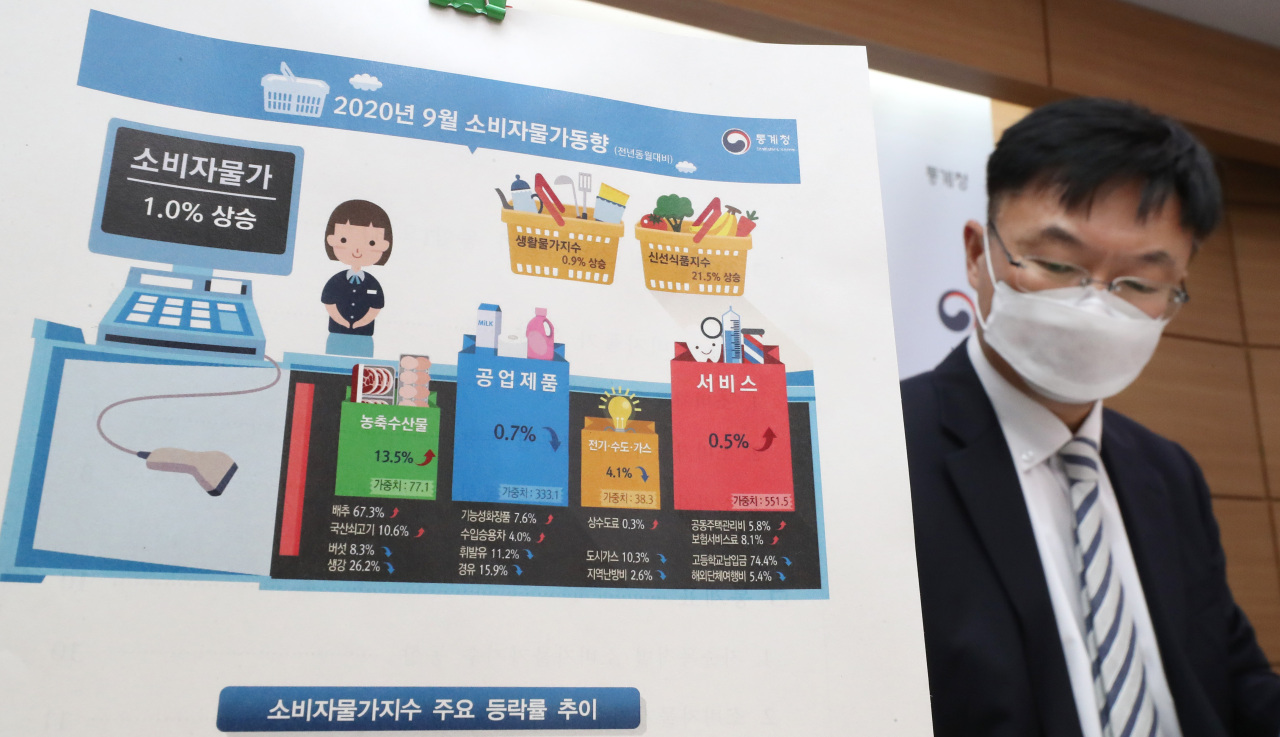Consumer inflation recovers to 1% in September
Effect may be temporary as increase driven by effect of heavy rain on food prices
By Bae HyunjungPublished : Oct. 6, 2020 - 15:17

South Korea’s consumer prices increased 1 percent on-year in September, marking the sharpest rise in six months, data showed Tuesday.
This was driven largely by the impact of the record-long rainy season, which caused prices of agricultural, livestock and fisheries goods to rise at the steepest rate in almost a decade.
The Consumer Price Index for September stood at 106.20, up 1 percent from a year earlier and returning to the 1 percent level for the first time since March, according to Statistics Korea. The given index indicates the consumer price change from the benchmark year 2015.
Throughout most of the first half of the year, the index had remained on a downtrend, becoming negative in May and only recovering to 0 percent in June. It has recovered since then, climbing to 0.3 percent in July and 0.7 percent in August.
But as consumers shunned eating out amid the prolonged epidemic crisis -- especially after the second mass outbreak in August -- consumer prices continued to stagger. The low oil prices and the government’s expanded fiscal support also kept inflation low, according to the statistics office.
“The long monsoon period led to a hike in agricultural goods but this was partly offset by low global oil prices and fiscal support programs in the education sectors,” Ahn Hyung-joon, deputy director general for economic trend statistics, said in a press briefing.
Amid improved weather conditions from late September, the vegetable prices are likely to stabilize by end-October, the official added.
The prices of agricultural, livestock and fisheries goods logged a combined 13.5 percent on-year rise in September, which was the steepest inflation since 14.6 percent observed in March 2011.
White radishes and napa cabbages -- materials essential in making kimchi -- saw average market prices spike 89.8 percent and 67.3 percent, respectively.
Livestock goods and fisheries saw 7.3 percent and 6 percent in on-year inflation, respectively.
Prices of petroleum goods, on the other hand, dipped 12 percent, consequently dragging down the overall industrial price index. Electricity and gas prices shed 4.1 percent on-year in September.
The oil prices are likely to fall further in October as it takes about a month until the global energy price factor is reflected in domestic indexes, Ahn added, citing the global oil price fall in September.
Core inflation, which excluded the price-sensitive agricultural and petroleum products, went up 0.9 percent in September from a year earlier.
The Organization for Economic Cooperation and Development price index, which excludes food and energy sector, went up 0.6 percent during the same period.
The fresh food index, which shows the inflation trend for the 50 most price vulnerable products, soared 21.5 percent, hitting the highest level since February 2011.
In the residential sector, housing rents climbed 0.4 percent on-year, indicating heavier burden for non-house-owners. The given figure includes both monthly rents and jeonse -- a localized property lease system in which tenants submit a lump sum deposit instead of a regular rent fee.
By Bae Hyun-jung (tellme@heraldcorp.com)



![[Herald Interview] 'Amid aging population, Korea to invite more young professionals from overseas'](http://res.heraldm.com/phpwas/restmb_idxmake.php?idx=644&simg=/content/image/2024/04/24/20240424050844_0.jpg&u=20240424200058)

![[Pressure points] Leggings in public: Fashion statement or social faux pas?](http://res.heraldm.com/phpwas/restmb_idxmake.php?idx=644&simg=/content/image/2024/04/23/20240423050669_0.jpg&u=)












